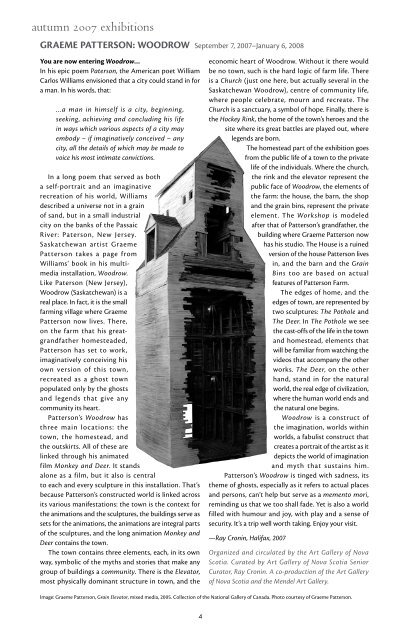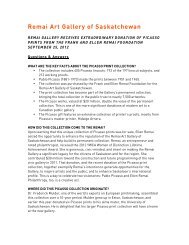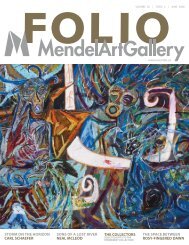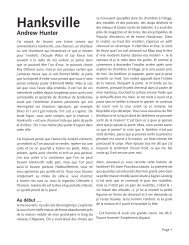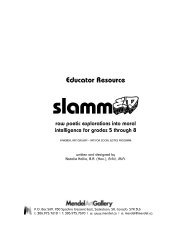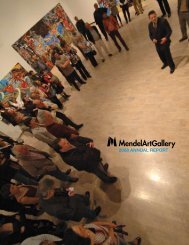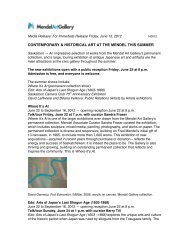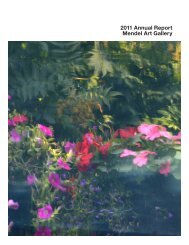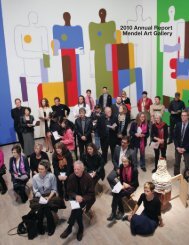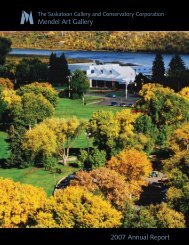The Mendel Art Gallery
The Mendel Art Gallery
The Mendel Art Gallery
You also want an ePaper? Increase the reach of your titles
YUMPU automatically turns print PDFs into web optimized ePapers that Google loves.
autumn 2007 exhibitions<br />
Graeme patterson: woodrow September 7, 2007–January 6, 2008<br />
You are now entering Woodrow…<br />
In his epic poem Paterson, the American poet William<br />
Carlos Williams envisioned that a city could stand in for<br />
a man. In his words, that:<br />
…a man in himself is a city, beginning,<br />
seeking, achieving and concluding his life<br />
in ways which various aspects of a city may<br />
embody – if imaginatively conceived – any<br />
city, all the details of which may be made to<br />
voice his most intimate convictions.<br />
In a long poem that served as both<br />
a self-portrait and an imaginative<br />
recreation of his world, Williams<br />
described a universe not in a grain<br />
of sand, but in a small industrial<br />
city on the banks of the Passaic<br />
River: Paterson, New Jersey.<br />
Saskatchewan artist Graeme<br />
Patterson takes a page from<br />
Williams’ book in his multimedia<br />
installation, Woodrow.<br />
Like Paterson (New Jersey),<br />
Woodrow (Saskatchewan) is a<br />
real place. In fact, it is the small<br />
farming village where Graeme<br />
Patterson now lives. <strong>The</strong>re,<br />
on the farm that his greatgrandfather<br />
homesteaded,<br />
Patterson has set to work,<br />
imaginatively conceiving his<br />
own version of this town,<br />
recreated as a ghost town<br />
populated only by the ghosts<br />
and legends that give any<br />
community its heart.<br />
Patterson’s Woodrow has<br />
three main locations: the<br />
town, the homestead, and<br />
the outskirts. All of these are<br />
linked through his animated<br />
film Monkey and Deer. It stands<br />
alone as a film, but it also is central<br />
to each and every sculpture in this installation. That’s<br />
because Patterson’s constructed world is linked across<br />
its various manifestations: the town is the context for<br />
the animations and the sculptures, the buildings serve as<br />
sets for the animations, the animations are integral parts<br />
of the sculptures, and the long animation Monkey and<br />
Deer contains the town.<br />
<strong>The</strong> town contains three elements, each, in its own<br />
way, symbolic of the myths and stories that make any<br />
group of buildings a community. <strong>The</strong>re is the Elevator,<br />
most physically dominant structure in town, and the<br />
economic heart of Woodrow. Without it there would<br />
be no town, such is the hard logic of farm life. <strong>The</strong>re<br />
is a Church (just one here, but actually several in the<br />
Saskatchewan Woodrow), centre of community life,<br />
where people celebrate, mourn and recreate. <strong>The</strong><br />
Church is a sanctuary, a symbol of hope. Finally, there is<br />
the Hockey Rink, the home of the town’s heroes and the<br />
site where its great battles are played out, where<br />
legends are born.<br />
<strong>The</strong> homestead part of the exhibition goes<br />
from the public life of a town to the private<br />
life of the individuals. Where the church,<br />
the rink and the elevator represent the<br />
public face of Woodrow, the elements of<br />
the farm: the house, the barn, the shop<br />
and the grain bins, represent the private<br />
element. <strong>The</strong> Workshop is modeled<br />
after that of Patterson’s grandfather, the<br />
building where Graeme Patterson now<br />
has his studio. <strong>The</strong> House is a ruined<br />
version of the house Patterson lives<br />
in, and the barn and the Grain<br />
Bins too are based on actual<br />
features of Patterson Farm.<br />
<strong>The</strong> edges of home, and the<br />
edges of town, are represented by<br />
two sculptures: <strong>The</strong> Pothole and<br />
<strong>The</strong> Deer. In <strong>The</strong> Pothole we see<br />
the cast-offs of the life in the town<br />
and homestead, elements that<br />
will be familiar from watching the<br />
videos that accompany the other<br />
works. <strong>The</strong> Deer, on the other<br />
hand, stand in for the natural<br />
world, the real edge of civilization,<br />
where the human world ends and<br />
the natural one begins.<br />
Woodrow is a construct of<br />
the imagination, worlds within<br />
worlds, a fabulist construct that<br />
creates a portrait of the artist as it<br />
depicts the world of imagination<br />
and myth that sustains him.<br />
Patterson’s Woodrow is tinged with sadness, its<br />
theme of ghosts, especially as it refers to actual places<br />
and persons, can’t help but serve as a memento mori,<br />
reminding us that we too shall fade. Yet is also a world<br />
filled with humour and joy, with play and a sense of<br />
security. It’s a trip well worth taking. Enjoy your visit.<br />
—Ray Cronin, Halifax, 2007<br />
Organized and circulated by the <strong>Art</strong> <strong>Gallery</strong> of Nova<br />
Scotia. Curated by <strong>Art</strong> <strong>Gallery</strong> of Nova Scotia Senior<br />
Curator, Ray Cronin. A co-production of the <strong>Art</strong> <strong>Gallery</strong><br />
of Nova Scotia and the <strong>Mendel</strong> <strong>Art</strong> <strong>Gallery</strong>.<br />
Image: Graeme Patterson, Grain Elevator, mixed media, 2005. Collection of the National <strong>Gallery</strong> of Canada. Photo courtesy of Graeme Patterson.


